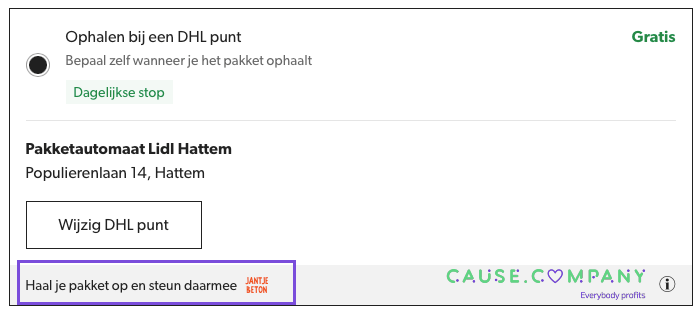Why do you continue to transfer your marketing budget to tech giants such as Google and Meta, when it can also support good causes? In a world where consumers are becoming more critical about where they buy and talent is scarce, social brands have an advantage. Not only do they attract customers more easily, they also fill their vacancies more quickly. Cause marketing, or linking your brand to a good cause, helps to bring your company’s social image to the fore.
Kruidvat
To start immediately with an example: everyone knows Kruidvat and everyone sometimes buys something at Kruidvat. It is therefore a brand that is for everyone.
To strengthen this image, Kruidvat collaborates with the Poverty Fund. For example, Kruidvat released a Christmas hit last Christmas in which all revenue from the streams went to the Poverty Fund. Kruidvat also sold special promotional products with donations made per purchase.
Kruidvat benefits both directly and indirectly from this collaboration. Due to the Christmas hit, people are increasingly thinking of Kruidvat in the run-up to Christmas and they have a positive association with a brand that is committed to helping people who are less fortunate. This ultimately creates additional turnover, especially in combination with special promotional products.
Not only large companies can apply cause marketing, every company has values and a mission for which a suitable charity can be found. For example, a local real estate agent can work well with homeless shelters and a wooden floor seller can combat deforestation. A suitable match can be found for every company.

Plankenland donates 2 trees for every wooden floor sold
Everyone benefits from cause marketing
The great thing about cause marketing is: it benefits everyone. A public partnership with a company gives the charity more brand awareness and gives the charity more certainty of donations.
Because companies that publicly connect with charities are less likely to cut back on that collaboration than companies that make incidental donations when things are going well, but do not do so when things are not going well.
Charities therefore benefit from cause marketing, but donating is also commercially interesting. Proper use of cause marketing helps companies to:
- Build positive brand associations: by sincerely dedicating yourself to a good cause, confidence in your brand and it gets a positive boost.
- Strengthen brand loyalty: customers feel much more connected to brands that consider the same social values important like them.
- Easier to attract talent: everyone is looking for meaning, companies that do more than make as much money as possible therefore have less difficulty attracting talent.
- Team building: as a team it feels good to jointly support a goal. Especially if you combine this with, for example, periodic volunteer work for a good cause. In fact, companies that integrate volunteerism into their culture perform 147% better than competitors without comparable initiatives.
And of course it is also nice to support a good cause as a company. Especially if it benefits everyone.
The basis of a good cause marketing strategy: The 5 m’s framework
While it’s tempting to immediately pick a cause and start rolling out a campaign, a well-thought-out strategy is essential. Here it comes 5 M’s cause marketing framework in pictures, this helps you think about the basis of your cause marketing campaign.
1. Motivation: why are you doing this?
Every marketing strategy starts with a clear goal. With cause marketing, that goal must go beyond just commercial results. If you just want to make a quick buck, you will be left out. The motivation behind your campaign must be authentic: you really want to do something good. Customers recognize when a company operates purely opportunistically.
I always say, “An antisocial company does not become social through cause marketing”. There are plenty of examples of companies that quickly wanted to polish their image, but in doing so damaged their brand. Think of Shell, which wanted to achieve a more sustainable image with CO2 compensation, but was rejected by the Advertising Code Committee or the example of RUMAG later in this article.
It is therefore crucial to sincerely want to contribute to the charity you choose. Ask yourself: is my intention really to help a good cause?
2. Match: choose the right charity
The choice of charity must logically connect with your brand. A sports shoe brand that is committed to health and well-being? That’s a natural fit. A tech company that collaborates with a digital inclusion organization? That feels right. The match between your brand and the charity must be credible to your audience and feel natural. The stronger the match, the more trust you build with your target group.
Do you find it difficult to find a match? Start with the mission and company values and from there look for a good cause that matches these.
3. Message: tell a clear story
As a marketer you are already used to telling stories. With cause marketing, your story is even more important. A good story is emotional and connects the charity with your company. Good storytelling is crucial here: don’t just tell what you do, but why it matters.
Questions you can answer are; Why are you doing this? Why is it important? What is the impact that the charity makes? How can consumers help?
In addition to a good story, it is also important to communicate openly and honestly. Make it clear exactly what you contribute to the charity, do not keep this vague, but be specific. So not with every sale of product X we donate to goal Y, but with every sale of product X we donate €4 to goal Y.
4. Methods: in what ways can you collaborate?
There are several ways you can collaborate with a charity:
- donate a fixed amount to charity
- donate a variable amount based on, for example, sales results
- volunteer with your team or employees
- help the charity by creating brand awareness
- giving customers the opportunity to donate themselves via your platform
Choosing the right collaboration methods is important to running a successful cause marketing campaign. When choosing the method for working together, it is important to be clear about your goals. For example, donating a fixed amount and paying attention to it creates a more positive image, but a donation per sale results in extra turnover more quickly.
A combination of different methods often works best. They reinforce each other because the collaboration always comes back in different forms.
For example, in addition to a donation, you can also involve your employees by having them do periodic volunteer work. This means that the goal is really supported within the company and you work on team building. You also give customers the opportunity to help, so that they also feel part of the action. You can use any moment through your marketing channels to talk about the collaboration. This way you repeat and reinforce the message.
5. Measurement: meet je impact
In the world of marketing, measuring is knowing. Just like with any other campaign, cause marketing requires you to measure your success. Depending on your campaign, it can sometimes be difficult to measure all the impact, but that is not a good reason not to measure at all.
For example, ask before and after your campaign how customers experience your brand, measure direct results such as turnover and don’t forget to measure the impact of your donations on the charity.
Internally, measuring helps to maintain support for the collaboration. A good cause marketing campaign is one that benefits both the charity and the company.
Measuring impact not only helps you see what works and what doesn’t, but also strengthens the credibility of your campaign. Afterwards, communicate what the collaboration has yielded for the good cause.
Successful examples of cause marketing
To show how powerful cause marketing can be, let’s look at some successful campaigns:
1. Wehkamp: sustainable shipping option
Wehkamp wants to encourage customers to choose shipping to a DHL ServicePoint instead of home delivery. This is probably the cheaper shipping option for Wehkamp and also more sustainable.
To encourage this green choice, Wehkamp uses cause marketing. For every order collected at a DHL ServicePoint, they donate a small amount to Jantje Beton. A great way to encourage the choice of a more sustainable and cheaper shipping option.

Wehkamp uses cause marketing to guide the choice of a delivery method (nudging)
2. Greetz: Jarige Job foundation
Card platform Greetz has designed a special card collection. And the great thing is: for every card sent, €1 goes to the Jarige Job Foundation. The Jarige Job Foundation treats children from the poorest families to an unforgettable birthday. They do not give money, but a birthday box full of decorations, treats for the class and teachers, something tasty for visitors and of course a nice gift.
If we look at Greetz’s mission, we read: ‘With Greetz you give attention to the one you love.’ This mission is strengthened by the collaboration, customers are encouraged to send another card. This not only creates additional turnover in the short term, but also in the long term. The more often someone sends a card, the faster it becomes a habit. A smart way to stimulate sales.
But perhaps even more important: Greetz ensures that children have a wonderful birthday. An acquaintance is happy with a card and an unknown child is happy with a beautiful birthday.

Greetz works together with the Jarige Job Foundation
3. RUMAG: that’s not how cause marketing works…
During the corona crisis, RUMAG showed how a cause marketing campaign can go wrong. The company, known for its sharp and often rude texts, sold t-shirts from which part of the proceeds would go to the Red Cross. At first glance, nothing seemed wrong.
Yet a lot of criticism arose, first online and in Quote, and then things went completely wrong when Sunday with Lubach paid attention to it. The criticism? RUMAG itself also made money from the campaign.
The problem was mainly in communication (message). It remained unclear whether and how much RUMAG itself earned from the t-shirts. This highlights how important transparency is in cause marketing. Always be crystal clear about how much is being donated and whether you make a profit yourself.
In addition, the match was also questionable. Shortly before this campaign, they sold face masks with texts like ‘GET.DE.CORONA.’ – not exactly empathetic. The brand had a rough, brutal image, which was completely at odds with a social campaign for the always neutral Red Cross.
Ready to start with cause marketing?
Almost all companies spend marketing money on tech giants like Google and Meta. Time to shift a bit of that budget to cause marketing. What could be better than donating money and benefiting from it yourself? Start by choosing a goal that fits your brand, tell an authentic story, and make sure you measure results to substantiate the value of your campaign.
But most importantly: just start! Start small and gain experience with cause marketing. From there, great collaborations naturally arise. Not only the company benefits, the charity can also do great things with the support. Everybody profits!
Source: www.frankwatching.com



